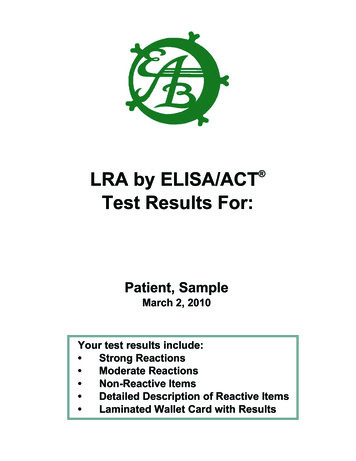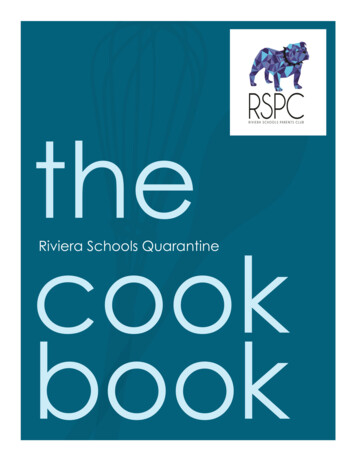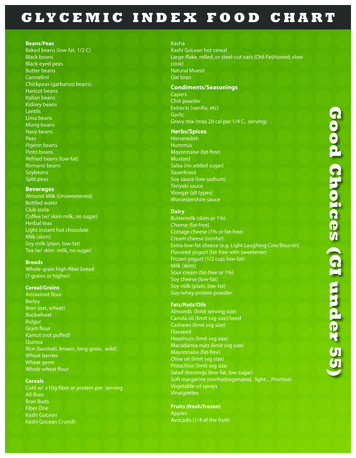
Transcription
Cottage Cheese:Agricultural processing brochureSouth African farmers facing current economic realities aresearching for new options to maintain or expand theirbusinesses. One of the many opportunities to grow markets,turnover and profits is by adding value to farm produce. Optionsneed to be selected carefully based on sound information andknowledge of the opportunities presenting themselves, takinginto account the strengths and weaknesses of individual farms.Introduction:Product group: Dairy productsDairy milk is one of the most versatile products available to theprocessor. Processing options include fermenting, concentrating,drying, freezing and many more methods of preservation.Processed dairy products are divided into five groups: Concentrated dairyproductsCultured dairy productsFrozen dairy productsLiquid dairy productsPowdered dairyproductsCottage cheese iscategorised as a cultureddairy product.Product description:Cottage CheeseCottage cheese is categorised asa cultured dairy product. Cottagecheese is the product obtainedfrom coagulated milk, cream,partly or wholly skimmed milk,reconstituted (prepared) milk, or acombination of these products.Cottage cheese is a soft,unripened cheese containingabout 80% moisture.Page 1Cottage cheese can also bemade with various additionssuch as herbs, pickles andspices.Cottage cheese is classified asfollows: Full fat cottage cheese mayalso be named cottagecheese, full cream cottagecheese,andcreamedcottage cheese has a fat indry matter content of atleast 45% but not more than60%.Please note the Disclaimer on page 7 Medium fat cottage cheesehas a fat in dry mattercontent of at least 25 % butnot more than 45 %. Low fat cottage cheese hasa fat in dry matter content ofat least 10 % but not morethan 25 %. Fat-free cottage cheesemay also be named skimmilk cottage cheese, has afat in dry matter content ofat least 10 %.
Storage of raw milk for processingMilk is a highly perishable product that may turn sour if left atroom temperature. Milk is cooled to improve its quality andstability. Milk leaves the cow at 37 C and must be cooledwithin 3 hours to 4 C. During cold storage, the milk must bestirred gently to prevent a cream layer from forming on top(cream separation by gravity). Raw milk is thus kept in largevertical tanks at the factory or processing plant, which is fittedwith one or more propeller agitator(s) until further processingproceeds.Milk preparation for the manufacturing of cheeseClarification of milkClarification is the removal of solid impurities (dirt particles, white blood cells and cells of udder tissue) fromthe milk, prior to further processing. Clarification is achieved through filtration.Pre-heating of milk for separationPrior to separation the milk is heated to 45 - 60 C to ensure effective separation of the skim milk and creamphase. Heating also inactivates the enzyme lipase that is responsible for the development of rancidity in fats.Pre-heating guarantees the highest possible cream quality, i.e. the lowest amount of free fat in skim milk.Fastfacts:Fresh milk should becooled to:Separation andstandardisation of milk forcheeseSeparation: The cream fraction ofraw milk is separated from theskim milk by passing pre-heatedraw milk (45 – 60 C) through aconventionalorhermeticcentrifugal separator.Standardisation follows directlyafter separation and involves theadjustment of the fat content ofmilk to obtain a product with adefined, guaranteed fat content.Cottage cheese products areclassified according to their fatcontent. The fat content of milkmust therefore be adjustedPage 24 ºCCCCcCCCCCCCCCCCCPrior to separation the milk isheated to:and standardised accordinglysince the fat content of raw milkvaries.Standardisationispreceded by separation of themilk and cream and then remixing the two fractions in thedesired proportions.Take note: Fat-free cottagecheese is made from skim milkand does not require re- mixingonly separation.Homogenisation of milk forcheese (optional)Homogenisation is the processwhere the fat globules in the milkproducts are finely distributed toreduce “creaming”, i.e. theseparation of the cream and skimPlease note the Disclaimer on page 745 - 60 º CCcCCCCCCCCmilk.Homogenisation is accomplishedby forcing the milk through asmall opening at high velocity tocause disruption of the large fatglobules to form small, stablefractions. Homogenisation is mosteffective when the milk is slightlyheated (60 - 70 C) and can bedone partially or completely.Homogenisation is an optionalprocess which has advantagesfor cheese processors but alsodisadvantages. The processormust decide which is moreimportant.
Advantages of homogenisation for cottage cheese: the uniform distribution of the fat globules,producing a smooth and creamy cottage cheese,a whiter coloured productDisadvantages include the following: the milk cannot be separated (cream and skimmedmilk),increased sensitivity to sunlight - leads to thedevelopment of a metallic taste,increased sensitivity to lipase (enzyme), andlow stability of the protein to temperature variations.Cottage Cheese Process1. Pasteurisation of milk for cottage cheesePasteurisation is a mild heat treatment that destroys all vegetative pathogens and heat sensitiveenzymes so that the phosphatase test gives a negative result. The milk is heated to 72 C, followed byrapid cooling. Although cheese made from unpasteurised milk is considered to have a better flavour andaroma, cheese milk is pasteurised to eliminate microbial competition for the starter culture and toprevent some common defects during ripening. Various pasteurisation methods are available,depending on the size of the processing plant.2. Forming the curd: Bacterial culture is added to the milk in the vat at 29 C to acidify the milk. The bacterial cultureintroduces ‘good’ bacteria, which plays an important role throughout the manufacturing process.4. Cutting the curd:Page 3Process overviewPlease note the Disclaimer on page 7
The temperature creates ideal conditions to coagulateand for the bacteria to grow, and the acidic environmenthelps prevent foreign bacterial contamination.Rennet is added to the milk when it reaches a certainpH. This causes casein protein in the milk3. Cutting of curd for cottage cheese:The coagulum is cut with vertical and horizontal knivesinto small cubes of between 0,5 - 1,2 cm. This easesthe whey separation (syneresis) by increasing theexposed surface areas. The cubes of curds and wheyare gently stirred to prevent lump formation. Somemaywheybe removed at this stage. The curd is then left to rest for about 15 minutes.4. Scalding of cottage cheese curds:Scalding is a heat treatment given to cheese curds to regulate the texture and acidification of the curd.The curds are slowly heated to 55 C to accelerate the whey separation. Slow heating is necessary toprevent case hardening. The curd-whey mixture is stirred as soon as the required temperature isreached to ease separation.5. Draining of whey from cottage cheese:Draining removes excess free moisture from a product by gravitation force to obtain partial drying ofthe product surface. The whey and the curd have separated due to cutting, stirring and scalding. Thewhey is drained off either through a tap or by gravity separation.Fastfacts:Number of washesWashing of cottage cheese curd :2-36. Washing of cottage cheesecurds (optional)The curds can be washed 2 3 times with potable water at30 - 32 C, 14 C and 4 Crespectively. This cools thecurds, removes excess acidand lactose and thus inhibitsfurtheracidformationthrough fermentation. All thewater is drained from thecurd.8. Filling and sealing ofcottage cheeseThe containers are filled byautomatic injection nozzles inlargeprocessing plants.Small processors can handfill and seal the containers.Suitable containers includeplastic tubs with foil and/orplastic lids. The containersshouldbehermeticallysealed and stored at 4 C.7. Seasoning of cottagecheese (optional)Salt and other optionalseasoningssuchaspeppercorns and herbs maybe added at this stage.9. Labelling of cottage cheeseAll the cottage cheesecontainers are pre-labelled orlabelled after they are filledand sealed.Page 4Please note the Disclaimer on page 7Temperature rangeº32 - 4 CLabelling of cheeseLabelling in South Africa iscontrolled by legislation. Anyonewho wants to use the informationprovided in this document mustfamiliarise him/herself with all theapplicable laws that apply to theproducing,processing,manufacturing and storage of theproducts referred to in thisdocument.Please also refer todisclaimer on the last page.the
Other processing options – Cultured dairy productsListed below are other processing options not covered in thisreport, but available from Eskom. Cultured buttermilk is the product obtained from milk thathas been inoculated with a starter culture to produce aviscous liquid with a mild lactic flavour. It is consumed as arefreshing drink or used as an ingredient in various bakedproducts. Gouda is a close textured, mild cheese. It is classified assemi-hard. Kefir is a smooth, viscous, fermented dairy drink with afresh acidic taste and contains lactic acid, alcohol ( 1%)and gas (carbon dioxide). Long life, set dessert is a cultured dairy product similar to yoghurt that has undergone a heat process toextend the keeping quality. Set long life dessert is fermented in the final retail container and has a gel-likea consistency. It may or may not be flavoured. Long life, stirred dessert is a cultured dairy product similar to yoghurt that has undergone a heattreatment to extend the keeping quality. Stirred long life dessert is produced in large batches prior topackaging in the final retail container. Maas (cultured milk) is manufactured by inoculating pasteurised milk with a specific bacterial culture.The end product has a firm texture, no gas bubbles and no separation of whey from the coagulum. It haspleasant sour taste with a slight bite/prickliness on the tongue. Processed cheese is made from a variety of natural cheeses that are ground and blended together withemulsifying agents. Various other additives may also be added. The mixture is heated and packaging inlaminated films. Ricotta is a cheese prepared from whey. Ricotta is a low fat, soft cheese with a maximum fat in dry mattercontent of 10% and a minimum dry matter of 20%. Set yoghurt is prepared from high or full fat pasteurised milk inoculated with a specific starter culture.Fermentation takes place in the final retail container under controlled conditions. The yoghurt has a firm,gel-like consistency and a clean surface is apparent when the yoghurt is cut. Stirred yoghurt is a fermented milk product with a thick, smooth consistency and may or may not beflavoured. It is incubated in tanks, stirred, flavoured and cooled before packaging. Cultured (sour) cream is the product obtained from cream that has been inoculated with a starter cultureto allow for the development of lactic acid and flavour compounds under controlled conditions. Cheese spread is a blend of hard cheese with added emulsifying salts. The mixture undergoes a heattreatment that increases the shelf life. Cheese spread has a relatively high moisture content ( 55 %) anda pH of 5,7 - 6,3. Cheddar cheese is defined as the product obtained from coagulated milk from which the whey has beenremoved. The coagulum or curd has undergone ripening to a greater or lesser extent. Cheddar isclassified as a high fat, hard cheese. Drinking yoghurt is essentially stirred yoghurt with a lower solids content and broken coagulum. It maybe pasteurised and/or aseptically packaged to extend the keeping quality. Feta is a pickled cheese with a clean, acidic salty taste. It is packaged in a brine solution to prevent dryingout and to preserve the cheese.Page 5Please note the Disclaimer on page 7
Energy Advisory ServicesEskom's role is to aid the client with basic information in thedecision-making process. Thereafter the Eskom Advisor will fulfilthe role of energy advisor as part of the team that the farmerselects.Optimise your energy useEskom’s Energy Advisors, in regions across South Africa, offeradvice to business customers on how to optimise their energy useby: Understanding their energy needs Understanding their electrical systems and processes Investigating the latest technology and processdevelopments, including electric infrared heating and drying systems Analysing how to reduce energy investment costs Optimising energy use patterns in order to grow businesses and industriesCall 08600 37566, leave your name and number and request that an Energy Advisor in your regioncontacts you. Alternatively, e-mail an enquiry to advisoryservice@eskom.co.za.Alternative funding:Five alternative funding product offerings are available to help reduce your investment costs for new agroprocessing or agro-beneficiation business or expand/improve an existing agro-processing oragro-beneficiation business.For more info visit: ternativefunding.aspxLiterature sources Catsberg, C.M.E. & Kempen van Dommelen, G.J.M. 1990. Food Handbook. New York: Ellis Horwood.Dairy Processing Handbook. 1995. Tetra Pak Processing Systems. Sweden.Fellows, P. 1988. Food Processing Technology: Principles and Practice. Chichester: Ellis Horwood,Ltd.Rosenthal, I. 1991. Milk and dairy products: properties and processing. Basel : VCH.Rothwell, J. (ed). 1989. Cream Processing Manual. Huntingdon: Society of Dairy Technology.South Africa - Agricultural Products Standards Act (No 119 of 1990)and regulations.Pretoria: Government Printers.South African - Foodstuffs, Cosmetics and Disinfectant Act (no 54 of 1972) and regulations.Johannesburg: Lex Patria.Tamine, A.Y. & Robinson, R.K. 1985. Yoghurt Science andTechnology. Oxford: Pergamon Press.Google free images: Product and other photos were sourced from Google images using a filter: Free toshare and use commercially.Page 6Please note the Disclaimer on page 7
DisclaimerThe reader’s attention is drawn to this notice which contains alimitation of risk or liability of Eskom, and constitutes anassumption of risk or liability by the reader or anindemnification of Eskom. The reader acknowledges thathe/she has made him/herself aware of this disclaimer and isaware that the disclaimer limits the liability of Eskom.The aim of this document is solely to provide the reader withsome basic information on agro processing in order tounderstand the extent of the operations involved.The reader should familiarise him/herself with all applicable laws that apply to the product growing,storage, processing and manufacturing. This information concentrates on the sequence and stepsinvolved in the processing of the selected product and explain the reason and necessity of each step. It isnot a complete reference document on which calculation and design shall be based, nor was it everintended to be.While Eskom has made every attempt to ensure that the information contained in this brochure has beenobtained from reliable sources, Eskom does not accept any responsibility or liability for the accuracy,content, completeness, legality, or reliability of the information contained in this brochure, and the readersor users are required to also make their own independent enquiry, before relying upon same. Allinformation in this brochure is provided "as is" with no warranties, promises and/or representations of anykind, expressed or implied, as to the nature, standard, accuracy or otherwise of the information providedin this brochure nor to the suitability or otherwise of the information for a purpose. Computer generatedimages, walkthroughs and render images used in this brochure are the artist's impression and are anindicative of the actual designs. The imagery used in the brochure may not represent actuals.Eskom shall not be liable to the reader for any loss or damage of whatever nature (direct, indirect,consequential, or other) incurred by the reader as a result of any action or omission related to theinformation provided in this brochure. The reader shall indemnify Eskom against any claim or actioninstituted by a third party as a consequence of the actions taken in relation to the contents of thebrochure, emanating from any area of law.For more information on Eskom’ssolutions and services visit the website www.eskom.co.za/idmIssued by Integrated Demand ManagementDate: November 2018Page 7
Cottage cheese is classified as follows: Full fat cottage cheese may also be named cottage cheese, full cream cottage cheese, and creamed cottage cheese has a fat in dry matter content of at least 45% but not more than 60%. Medium fat cottage cheese has a fat in dry matter content of at least 25 % but not more than 45 %.










